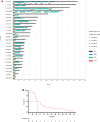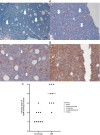Sensitization of Non-M3 Acute Myeloid Leukemia Blasts to All-Trans Retinoic Acid by the LSD1 Inhibitor Tranylcypromine: TRANSATRA Phase I Study
- PMID: 40459012
- PMCID: PMC12319880
- DOI: 10.1111/ejh.14426
Sensitization of Non-M3 Acute Myeloid Leukemia Blasts to All-Trans Retinoic Acid by the LSD1 Inhibitor Tranylcypromine: TRANSATRA Phase I Study
Abstract
The treatment of elderly, nonfit acute myeloid leukemia (AML)/MDS patients with relapsed/refractory (R/R) disease remains challenging. As histone demethylase LSD1 (KDM1A) is a rational therapeutic target in AML, we conducted a phase I trial ("rolling-six design") with the LSD1 inhibitor tranylcypromine (TCP, dose levels [DL] 20, 40, 60, 80 mg p.o. d1-28) combined with fixed-dose ATRA (45 mg/m2 p.o. d10-28) and low-dose cytarabine (LDAC, 40 mg s.c. d1-10). The primary endpoint was dose-limiting toxicity (DLT) in the first 28 days of treatment. The aim was the determination of the maximum tolerated TCP dose (MTD). Twenty-three patients with AML and 2 with MDS were accrued. TCP was administered for a median of 39.5 days (range: 11-228). No DLTs were observed at any DL; MTD could not be established. No differentiation syndrome occurred. Two patients attained a PR; SD was achieved in 10 of 22 evaluable patients. Median OS was 62 days (range: 14-325). Accompanying studies included pharmacokinetics, serial determinations of fetal hemoglobin (HbF), detection of CD38 upregulation with treatment, as well as transcriptome changes in purified blood blasts over time. In conclusion, the combination of TCP with ATRA and LDAC was well feasible, even at the highest DL. Hence, studies with more potent LSD1 inhibitors appear warranted. Trial Registration: German Clinical Trials Register (DRKS): DRKS00006055. For further Information see https://drks.de/search/en/trial/DRKS00006055.
Keywords: CD38; LSD1; chromatin; differentiation; histone demethylase; myelodysplastic syndrome.
© 2025 The Author(s). European Journal of Haematology published by John Wiley & Sons Ltd.
Conflict of interest statement
The authors declare no conflicts of interest.
Figures




Similar articles
-
Bexmarilimab plus azacitidine for high-risk myelodysplastic syndrome and relapsed or refractory acute myeloid leukaemia: results from the dose-escalation part of a multicentre, single-arm, phase 1/2 trial.Lancet Haematol. 2025 Jul;12(7):e516-e528. doi: 10.1016/S2352-3026(25)00103-6. Epub 2025 May 28. Lancet Haematol. 2025. PMID: 40449509 Clinical Trial.
-
Clinical Responsiveness to All-trans Retinoic Acid Is Potentiated by LSD1 Inhibition and Associated with a Quiescent Transcriptome in Myeloid Malignancies.Clin Cancer Res. 2021 Apr 1;27(7):1893-1903. doi: 10.1158/1078-0432.CCR-20-4054. Epub 2021 Jan 25. Clin Cancer Res. 2021. PMID: 33495312 Free PMC article. Clinical Trial.
-
Thrombopoietin mimetics for patients with myelodysplastic syndromes.Cochrane Database Syst Rev. 2017 Sep 30;9(9):CD009883. doi: 10.1002/14651858.CD009883.pub2. Cochrane Database Syst Rev. 2017. PMID: 28962071 Free PMC article.
-
Efficacy and feasibility of cyclophosphamide combined with intermediate- dose or high-dose cytarabine for relapsed and refractory acute myeloid leukemia (AML).J Cancer Res Clin Oncol. 2014 Aug;140(8):1391-7. doi: 10.1007/s00432-014-1666-7. Epub 2014 Apr 12. J Cancer Res Clin Oncol. 2014. PMID: 24728467 Free PMC article.
-
Comparison of first-line chemotherapy including escalated BEACOPP versus chemotherapy including ABVD for people with early unfavourable or advanced stage Hodgkin lymphoma.Cochrane Database Syst Rev. 2017 May 25;5(5):CD007941. doi: 10.1002/14651858.CD007941.pub3. Cochrane Database Syst Rev. 2017. PMID: 28541603 Free PMC article.
References
-
- Tchekmedyian R., Elson P., Gerds A. T., et al., “Analysis of Outcomes of Patients With Relapsed/Refractory Acute Myeloid Leukemia Treated in Randomized Clinical Trials,” Blood 128, no. 22 (2016): 4000, 10.1182/blood.V128.22.4000.4000. - DOI
-
- Stomper J., Rotondo J. C., Greve G., and Lübbert M., “Hypomethylating Agents (HMA) for the Treatment of Acute Myeloid Leukemia and Myelodysplastic Syndromes: Mechanisms of Resistance and Novel HMA‐Based Therapies,” Leukemia 35, no. 7 (2021): 1873–1889, 10.1038/s41375-021-01218-0. - DOI - PMC - PubMed
Publication types
MeSH terms
Substances
Grants and funding
LinkOut - more resources
Full Text Sources
Medical
Research Materials
Miscellaneous

